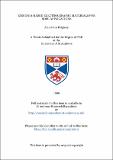Files in this item
Studies of possible solid oxide fuel cell anode materials in the MgO:TiO2:ZrO2 ternary system
Item metadata
| dc.contributor.advisor | Irvine, John T. S. | |
| dc.contributor.author | Sutherland, John D. W. | |
| dc.coverage.spatial | 128 p. | en_US |
| dc.date.accessioned | 2018-05-30T08:33:27Z | |
| dc.date.available | 2018-05-30T08:33:27Z | |
| dc.date.issued | 1997-06 | |
| dc.identifier.uri | https://hdl.handle.net/10023/13602 | |
| dc.description.abstract | The MgO:TiO2 :ZrO2 ternary system was investigated as a possible novel anode material in a solid oxide fuel cell. Titanium-substituted yttria-stabilised zirconias have the necessary electrical conductivity properties for a ZrO2 -based fluorite electrode but problems have been encountered such as a decrease in unit-cell size upon reduction leading to mechanical failure. By incorporating magnesium into the titanium-stabilised zirconia structure, it was thought that the cubic-fluorite structure might be stabilised. A phase diagram study was made of the MgO:TiO2 : ZrO2 ternary system at 1500°C. Upon researching the literature phase diagram of the MgO:TiO2 :ZrO2 system, it was found that the authors had not studied the single-phase region in the ZrO2 -rich area extensively and did not use a consistent temperature for their analysis of samples. This has meant that the phase diagram has had to be reinvestigated. The results obtained at 1500°C are in disagreement with the previously published phase diagram. A large area bounded by single-phase cubic-fluorite was detected; however the central region of this domain contained both tetragonal and cubic-fluorite domains. This implies that for the central region of this phase area that the cubic- fluorite phase is not stable at 1500°C. Selected stabilised cubic-fluorite samples with ~ 10 atom% Mg were annealed at l000°C after preparation at 1500°C and it was found that due to the presence of other phases present at 1000°C, that the cubic-fluorite phase is thermodynamically unstable at lower temperatures. DTA analysis revealed that as the titanium content in the cubic-fluorite solid-solution increased, the phase transition from tetragonal phase (+ MgO) to cubic-fluorite phase decreased. These results were used to provide a basis for a temperature phase diagram showing the likely phase transitions that occur at a particular temperature range. The activation energy for conduction increased and ionic conductivity decreased with increasing titanium content in the solid solution, due to the effects of local distortions created by the smaller ionic radius of titanium when compared to zirconium. | en_US |
| dc.language.iso | en | en_US |
| dc.publisher | University of St Andrews | |
| dc.subject.lcc | TK2931.S9 | |
| dc.subject.lcsh | Solid oxide fuel cells | |
| dc.title | Studies of possible solid oxide fuel cell anode materials in the MgO:TiO2:ZrO2 ternary system | en_US |
| dc.type | Thesis | en_US |
| dc.type.qualificationlevel | Doctoral | en_US |
| dc.type.qualificationname | PhD Doctor of Philosophy | en_US |
| dc.publisher.institution | The University of St Andrews | en_US |
This item appears in the following Collection(s)
Items in the St Andrews Research Repository are protected by copyright, with all rights reserved, unless otherwise indicated.

